How to Grow Tomato Plants: Growing Guide for All Types
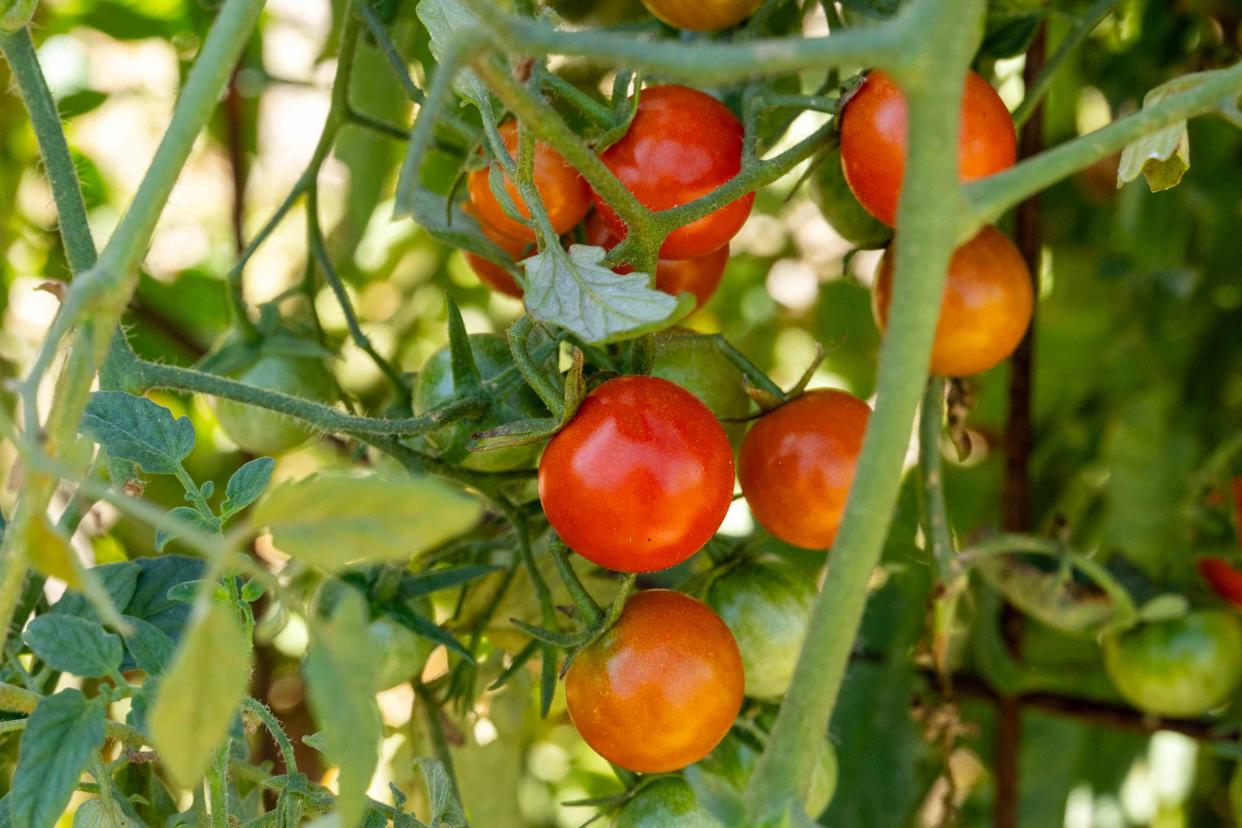
The Spruce / Jayme Burrows
Reviewed by Debra LaGattuta
Tomato plants (Solanum lycopersicum) are beloved by gardeners, with over 10,000 possible types to grow. These leafy annuals grow juicy, flavorful fruits in shades of red, yellow, orange, purple, pink, brown, and green. Plant tomatoes in late spring or early summer once all danger of frost has passed. Depending on the variety, tomatoes can be ready to harvest anywhere from 42 to 110 days from germination.
Here's a guide for how to grow tomato plants, including finding the best planting location, care requirements, and harvesting.
Fast Facts
Start tomato seeds indoors six to eight weeks before your region's last frost date.
Choose a planting site with loamy, well-drained soil and at least eight hours of full sun daily.
Wait until night temperatures remain above 50 degrees to plant tomato plants outdoors.
Support tomato plants with stakes or cages once they're ten to 12 inches tall.
Pinch off or prune suckers on indeterminate tomato varieties throughout the growing season.
Harvest ripe tomatoes when they're fully colored and firm yet supple, with smooth, shiny skin.
Common Name: | Tomato |
Botanical Name: | Solanum lycopersicum |
Family: | Solanaceae |
Plant Type: | Annual, fruit |
Size: | Depends on variety; can be three to six feet tall |
Sun Exposure: | Full |
Soil Type: | Loamy, well-drained |
Soil pH: | Neutral to acidic |
Bloom Time: | Summer |
Hardiness Zones: | 3-11 (USDA) |
Native Area: | South America |
How to Plant Tomatoes
When to Plant
Plant tomato seedlings outdoors after all danger of frost has passed and night temperatures are consistently above 50 degrees Fahrenheit. Store-bought and home-grown seedlings need to be hardened off before planting outdoors.
When the weather is warm enough, begin hardening off the seedlings by bringing them outdoors in the shade for a few hours each day, gradually increasing how much light they receive and their time outdoors. Once night temperatures are consistently above 50 degrees, you can transplant tomato seedlings outdoors.
Where to Plant
Choose a well-drained planting site with loamy soil and eight hours of direct sunlight daily. Practice crop rotation: wait three years before planting tomatoes in a bed where you've grown other crops in the nightshade family (tomatoes, eggplants, potatoes, peppers, and tomatillos) to help keep plants disease-free. Water tomato plants well before planting.
How to Plant
Plant tomatoes 18 to 24 inches apart, three to four feet between rows, for proper airflow. Indeterminate varieties need more space than determinate varieties because they don't stop growing until frost kills the plant. Check seed packets and seedling tags for spacing guidelines for your plant varieties.
To transplant tomato seedlings, dig a planting hole deep enough so the soil line is below the bottom-most healthy leaves. Planting deeply means digging the planting hole deep enough that 2/3 of the main stem is buried underground. Remove a few sets of the bottom leaves to create a longer stem. Only 1/3 of the plant should be visible above ground.
The stem will develop roots from any part buried in the soil, which leads to extra-strong plants. A bigger root system means your plants can absorb more water and nutrients, resulting in a healthier plant that is less susceptible to drought, disease, and attack by tomato pests.
Tip
As you plan your garden, allow plenty of space for your tomato crop. Tight spacing will inhibit airflow, which can cause diseases in mature and immature plants.
How to Start Seeds Indoors
Start tomatoes from seed indoors six to eight weeks before your region's first frost date. Fill seed trays with soilless seed starting mix and moisten the soil well. Plant tomato seeds a quarter-inch deep and cover them with soil. Put the trays in a warm place under a grow light. When the seedlings are two to three inches tall, pot them up into three-inch pots, burying them up to the lowest leaves.
How to Grow Tomato Plants in Pots
Because they grow only to a specific size, determinate tomatoes (sometimes called bush tomatoes) are ideal for container planting, although some indeterminate types are bred for pot planting.
Use a high-quality soilless potting mix that's light and drains well while holding onto necessary moisture. Mix in organic compost before planting to add fertility.
Use 14- to 20-inch pots with ample drainage holes; the larger, the better.
Tomatoes planted in containers generally benefit from cages or other supports.
Keep them well-watered because container plants dry out more quickly in hot weather than in-ground plants.
Tomato Plant Care

The Spruce / Jayme Burrows
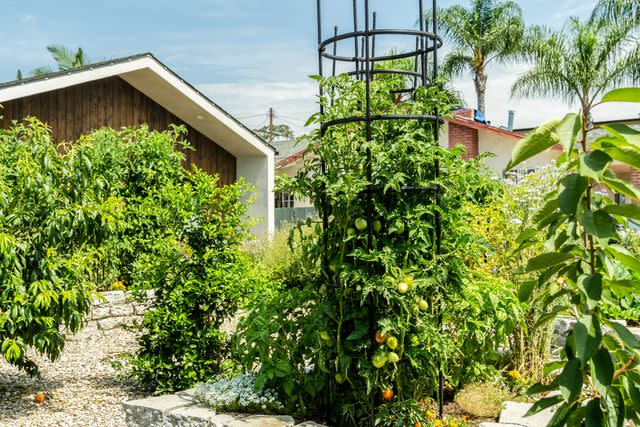
The Spruce / Jayme Burrows

The Spruce / Jayme Burrows
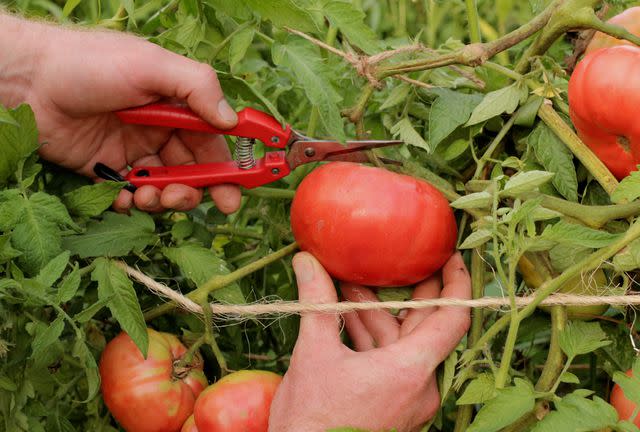
The Spruce / Steven Merkel
Light
Tomatoes require eight hours or more of direct sunlight daily to grow, flower, and fruit. In warmer regions like the southern United States, tomatoes might benefit from afternoon shade during the hottest times.
Soil
Plant tomatoes in a site with rich, well-drained soil. Choose a spot with soil that is slightly acidic loam or sandy loam. Work organic matter into the soil in the autumn or a few weeks before you plan to plant.
Water
Water tomato plants regularly to ensure they receive at least one inch per week. Consistent watering will help produce the best-quality fruit.
Apply water directly to the soil at the plant's root zone rather than sprinkling water overhead and wetting the foliage. Keeping the foliage dry will reduce the chance of fungal diseases.
Mulching with organic material like hay, straw, or grass clippings not treated with pesticides can help retain soil moisture.
Temperature and Humidity
Tomatoes can grow well at various humidity levels but need warm temperatures to survive and thrive. Temperatures below 50 degrees Fahrenheit can stunt growth and damage the plant's ability to produce flowers and fruit. Daytime temperatures above 85 degrees can cause blossom drop, but you can help keep plants withstand the heat by mulching the soil around plants and keeping them well watered.
Fertilizer
Tomato plants require nutrient-rich soil to grow and produce healthy fruit. To ensure your tomato plants receive the nutrients they need, a soil test can help you determine the soil contents, lacking nutrients, and the type of fertilizer your soil needs for good tomato growth.
If the soil is rich and fertile or has enough organic matter or compost before planting, you might not need to apply additional fertilizer throughout the growing season. However, tomato plants usually benefit from fertilizer application at several different points in their growth cycle. To encourage more flowering and fruiting rather than foliage growth, choose a fertilizer that's higher in phosphorous and lower in nitrogen.
Pollination
Tomatoes are self-fertile, meaning you don't need more than one plant for pollination. Movement from the wind is usually adequate to ensure pollination. However, adding a few summer-blooming annuals to the vegetable beds is ideal to attract pollinators such as bees and other insects. In high tunnels or greenhouses, growers use strategies like tapping tomato cages or stakes to help move pollen from the male to the female parts of the flower.
However, a few different issues can cause pollination issues. High daytime temperatures (over 90 degrees F) and low night temperatures (under 50 degrees F) can inhibit pollination and cause blooms to drop before they can set fruit. Insufficient water can also cause issues with flowering and pollination, and so can applying fertilizer that is too high in nitrogen, which causes plants to put energy toward foliage growth instead of flowering and fruiting.
Types of Tomato Plants
Tomatoes are treasured for their taste and nutritional benefits, which include phytochemicals and nutrients like lycopene, potassium, iron, folate, vitamin C, and other antioxidants. There are thousands of tomato varieties, including lower classifications, from heirlooms to hybrids. Tomato plant growth habits are also divided into two main categories: determinate and indeterminate.
Determinate Tomato Plants
Determinate tomatoes mature relatively early, growing to a mature size of three to four feet tall. All fruit on the plant ripens within roughly two weeks, and then plants die back. Because determinate tomato plants are usually compact, they're great for container growing and don't require heavy staking as indeterminate tomatoes do. Determinate tomatoes are often used for sauce and canning. Other determinate types are:
Roma: This plum tomato produces heavy yields of medium, rich red, meaty fruit.
Celebrity (Solanum lycopersicum 'Celebrity'): Determinate celebrity tomatoes are disease-resistant and prolific, with the added bonus that they fruit from when plants reach their mature size until frost. But unlike indeterminate tomatoes, they don't keep growing larger as the season progresses.
Rutgers: This heirloom variety, in production since 1934, produces bright red fruit with heavy walls and great disease resistance. It ripens evenly, inside and out, making it an easy-care cultivar that is equally delicious, fresh, cooked, or preserved.
Marglobe: This variety is adaptable to various soils and produces thick-walled fruit. It is very good to eat fresh or canned.
Indeterminate Tomato Plants
Indeterminate tomatoes include most cherry tomato varieties, heirloom tomatoes, and beefsteak tomatoes. Instead of growth stopping once fruit sets, indeterminate tomatoes will keep growing and fruiting until the first fall frost kills the plant. Because they keep growing, they require sturdy staking and regular pruning. They're also better suited to in-ground planting. Here are a few popular varieties:
Better Boy (Solanum lycopersicum 'Better Boy'): This popular indeterminate slicing tomato offers disease resistance, relatively early harvest, and sizeable one-pound fruits.
Yellow Pear (Solanum lycopersicum 'Yellow Pear'): Known for its clusters of sweet, pear-shaped yellow tomatoes, this indeterminate variety dates back to the early 19th century.
Green Zebra (Solanum lycopersicum' Green Zebra'): A cross between four different heirloom tomatoes, this indeterminate "heirloom hybrid" is prized for its bright flavor and chartreuse color.
Pink Brandywine (Solanum lycopersicum 'Brandywine'): This indeterminate, easy-to-grow heirloom offers hefty, flavorful fruits in a beautiful blush shade.

The Spruce / K. Dave
Vining indeterminate tomatoes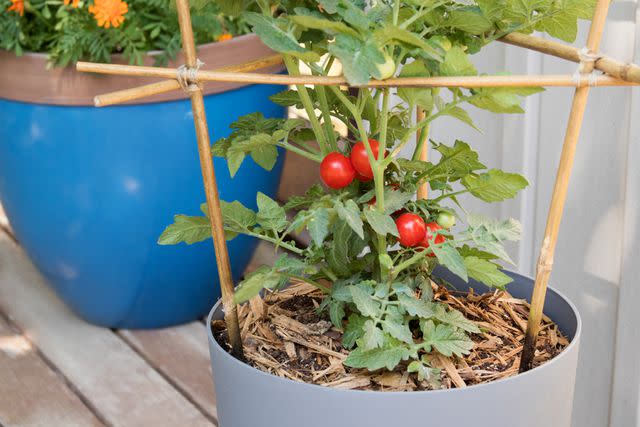
The Spruce / Colleen & Shannon Graham
Determinate tomatoes growing in a container
The Spruce / Steven Merkel
'Better Boy' tomatoes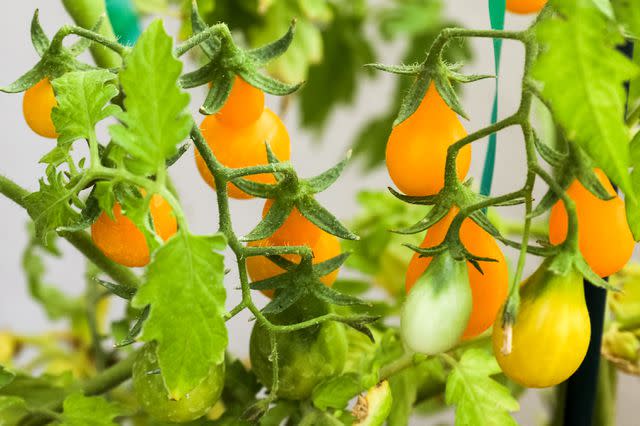
The Spruce / Jayme Burrows
'Yellow Pear' tomatoes
The Spruce / Jayme Burrows
'Green Zebra' tomatoes
Chiot's Run / flickr / CC BY-NC 2.0
'Pink Brandywine' tomatoes
The Spruce / Steven Merkel
'Celebrity' tomatoesVarieties of Tomatoes: Early Season, Mid-Season, and Late-Season
Another factor to consider when choosing tomato varieties is how long it takes for fruits to mature and be ready to harvest. Early-season varieties will grow ripe, ready-to-harvest fruit in 42 to 70 days. Mid-season tomatoes mature in around 70 to 80 days, while late-season varieties take 80 to 110 days to mature.
Pruning
Pruning tomatoes can offer several benefits, such as earlier harvests, disease resistance, and larger fruits. It's recommended to pinch or prune away the suckers—shoots that grow out of the axils where leaves meet stems—in indeterminate tomato varieties. This allows plants to direct energy towards fruiting rather than excess leaf growth and keeps plants tidier and generally easier to maintain. While determinate varieties are not always pruned, plants can develop stronger stems if you remove suckers that grow below the lowest flower.
Harvesting Tomatoes
Harvest tomatoes when fruits have fully colored, with a firm yet supple texture and healthy size for their variety. Ripe tomatoes will have smooth, shiny skin. Use scissors or pruners to cut stems when harvesting because pulling fruits off the vine can damage the plant. When a frost is forecast, remove all fruit from in-ground plants.
Tip
At the end of the growing season, before the first fall frost, harvest green tomatoes that have begun to color and place them in a paper bag or wrap them in newspaper to finish ripening. You can also use green tomatoes in certain recipes.
Propagating Tomato Plants
You can use the suckers you remove from your plants to propagate new plants. Here's how:
Pinch or prune off a good-sized sucker from a mature tomato plant. Remove the leaves on the lower half of the sucker stem.
Poke a hole in the soil nearby, leaving adequate space between plantings.
Plant the sucker in the hole. Roots will grow along the portion of the sucker's stem that is below the soil line.
When you see new growth, you'll know the sucker has rooted. You can leave it in place, dig it up, and relocate it to another area of your garden.
Care for the plant as you would any tomato plant.
Common Pests and Plant Diseases
Tomatoes can fall prey to diseases and garden pests. Plant disease-resistant varieties and prevent issues from happening with crop rotation, applying water to the soil and root zone rather than wetting the foliage with overhead watering, cutting away lower branches that might come into contact with soil, pruning suckers, and giving plants adequate space to enable airflow. Tomato diseases can be fatal if you don't identify, treat, and try to prevent them from occurring.
Treat insects like aphids by spraying them off with water or treating plants with neem or horticultural oil. Some pests, like tomato hornworms, must be picked off by hand.
Frequently Asked Questions
Do tomato plants need sun or shade?
Tomato plants require full sun to grow. Put them in a spot that receives at least eight to ten hours of direct sunlight daily.
How long do tomatoes take to grow?
Tomato plants take anywhere from 42 to 110 days to produce mature fruit, depending on your chosen variety and the climate in your region.
Is it better to plant tomatoes in pots or in the ground?
Generally, planting tomatoes in the ground will yield stronger plants since their roots can spread and root deeply. However, using varieties known for growing well in pots can produce good results in large, deep containers.
What are the best companion plants to grow with tomatoes?
Basil and marigolds are some of the most popular companion plants for tomatoes. When planted alongside tomatoes, a variety of herbs, flowers, and vegetables can help deter pests, attract beneficial insects, and suppress weeds.
Read Next: Vining Tomatoes vs. Bush Tomatoes: What's the Difference?
Read the original article on The Spruce.

